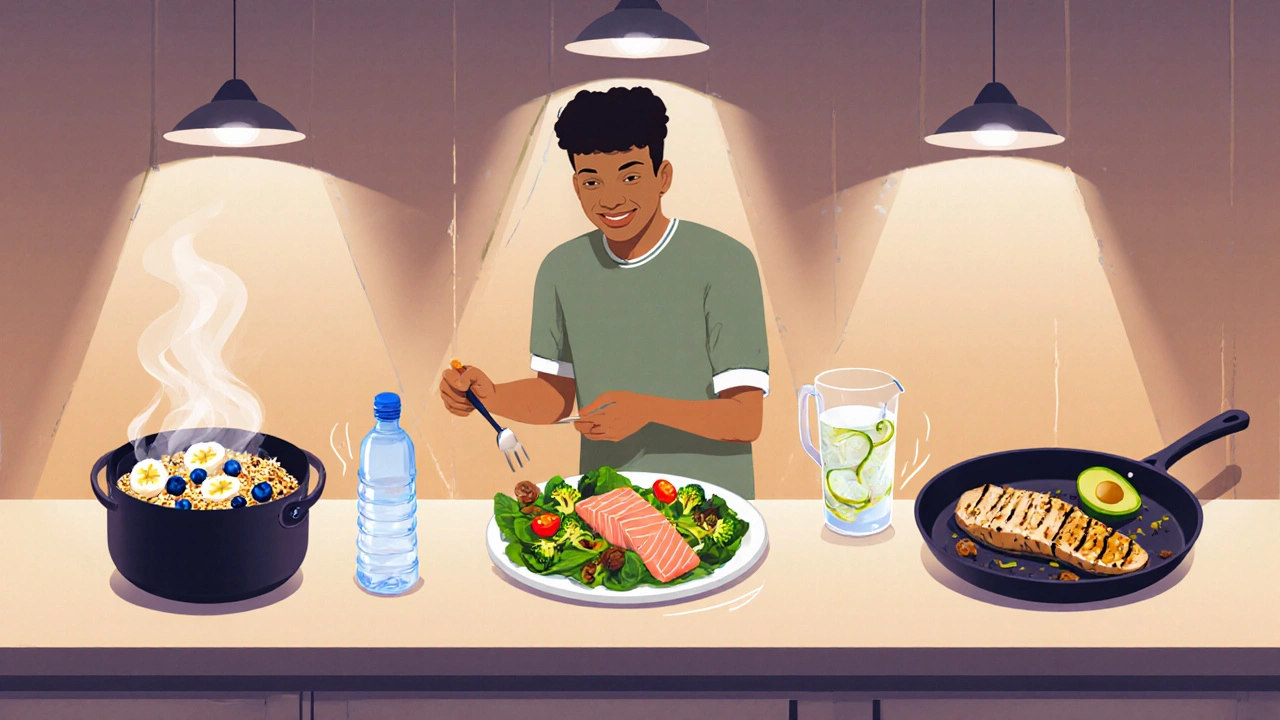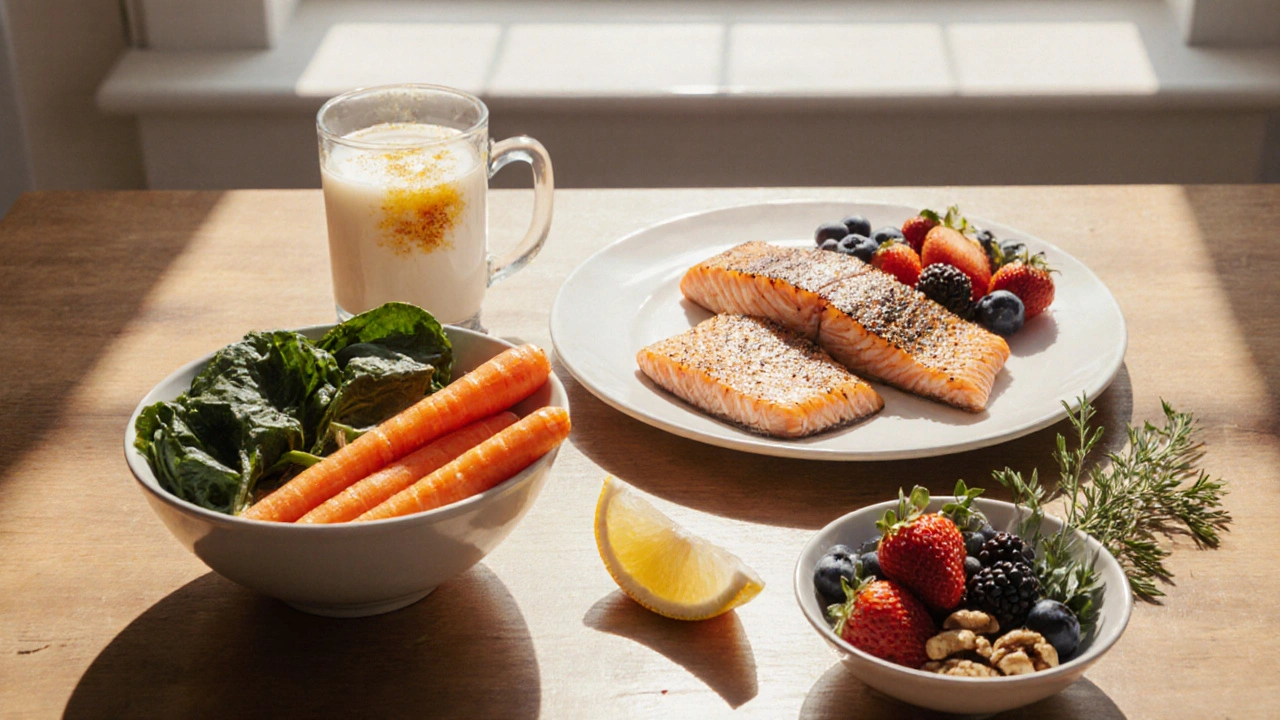Sickle Cell Diet Planner
Essential Nutrients for Sickle Cell Management
Iron
Essential for hemoglobin production. Balance is key to avoid oxidative stress.
Folate
Supports red blood cell production and DNA repair. Low levels increase crisis risk.
Vitamin D
Modulates immunity and supports bone health. Deficiency is common and problematic.
Omega-3
Anti-inflammatory fats that improve cell membrane flexibility and reduce sickling.
Antioxidants
Neutralize free radicals that accelerate sickling. Reduce oxidative damage.
Hydration
Prevents blood thickening and sickle cell crises. Adequate fluid intake is crucial.
Daily Meal Plan Recommendations
- Iron with vitamin C (citrus fruits) to boost absorption
- Omega-3 with anti-inflammatory spices like turmeric
- Leafy greens with healthy fats to aid nutrient uptake
Breakfast
Whole-grain oats with berries and walnuts for iron, folate, and omega-3.
Lunch
Salmon salad with spinach and quinoa for omega-3, iron, and folate.
Dinner
Grilled chicken with broccoli and brown rice, seasoned with turmeric for anti-inflammatory benefits.
Snacks
Carrot sticks with hummus or Greek yogurt with berries for sustained energy.
Hydration Tracker
Drink at least 2.5 liters daily, adjusting based on activity level.
Personalized Nutrition Plan
Your daily plan includes:
- Hydration: Drink at least liters of water daily
- Iron Sources: Lean meats, spinach, fortified cereals
- Folate Rich Foods: Dark leafy greens, beans, citrus fruits
- Omega-3: Salmon, walnuts, chia seeds
- Antioxidant-Rich: Berries, citrus, green tea
Sickle Cell Anemia is a hereditary disorder that causes red blood cells to become rigid and sickle‑shaped, leading to chronic pain, anemia, and organ damage. While medication like hydroxyurea plays a central role, what you eat can ease symptoms, boost energy, and reduce crises.
Key Takeaways
- Balanced intake of iron, folate, vitamin D, and omega‑3 fatty acids supports blood health.
- Hydration and low‑sodium foods help prevent sickling episodes.
- Whole‑food meals that combine protein, complex carbs, and healthy fats reduce inflammation.
- Regular monitoring of nutrient levels guides adjustments to your diet plan.
- Planning ahead and staying consistent make it easier to stick to a sickle cell diet that works for you.
Why Nutrition Matters for Sickle Cell Anemia
Understanding the biology helps you choose foods that actually help. The disease disrupts hemoglobin the protein that carries oxygen inside red blood cells. When sickled cells block small vessels, oxygen deprivation triggers pain episodes.
Consuming nutrients that enhance red blood cells the carriers of hemoglobin and oxygen throughout the body can improve their flexibility and lifespan. In short, good nutrition becomes a daily, low‑risk strategy to complement medical treatment.
Essential Nutrients and Their Role
Here are the five nutrients that research and clinical practice consistently flag as critical for people with sickle cell:
- Iron an essential mineral for hemoglobin synthesis. Iron deficiency worsens anemia, but excess iron can fuel oxidative stress, so balance is key.
- Folate (Vitamin B9) helps produce new red blood cells and supports DNA repair. Low folate levels correlate with higher crisis frequency.
- Vitamin D modulates immune function and reduces inflammation. Deficiency is common in sickle cell patients and linked to bone health issues.
- Omega‑3 Fatty Acids anti‑inflammatory fats found in fish, flaxseed, and walnuts. They improve cell membrane fluidity, making red cells less likely to sickle.
- Antioxidants compounds like vitamin C, vitamin E, and polyphenols that neutralize free radicals. Oxidative damage accelerates sickling, so a diet rich in antioxidants can dampen that effect.
Foods to Embrace
Pick whole, minimally processed options that pack the nutrients above.
- Lean meats, poultry, and eggs - excellent iron and protein sources.
- Dark leafy greens (spinach, kale, collard greens) - high in folate and iron.
- Fortified cereals and whole grains - steady iron and B‑vitamins.
- Fatty fish (salmon, mackerel, sardines) - prime omega‑3 providers.
- Seeds and nuts (flaxseeds, chia, walnuts) - plant‑based omega‑3 and antioxidants.
- Citrus fruits and berries - vitamin C improves iron absorption and adds antioxidants.
- Low‑fat dairy or fortified plant milks - vitamin D and calcium for bone strength.

Foods to Limit or Avoid
Some foods can aggravate dehydration, inflammation, or iron overload.
- High‑sodium processed snacks and canned meals - excess sodium drives dehydration and raises blood pressure.
- Excessive red meat without proper iron monitoring - can tip into iron overload.
- Deep‑fried foods and trans‑fat laden items - increase systemic inflammation.
- Sugary drinks and sodas - contribute to dehydration and spikes in blood glucose, which may trigger crises.
- Alcohol in large quantities - interferes with nutrient absorption and can worsen anemia.
Sample One‑Day Meal Plan
This plan hits the target nutrients while staying realistic for busy lives.
| Meal | Food Items | Key Nutrients |
|---|---|---|
| Breakfast | Whole‑grain oatmeal topped with sliced banana, walnuts, and a splash of fortified soy milk | Iron, folate, omega‑3, vitamin D, antioxidants |
| Mid‑morning Snack | Greek yogurt (low‑fat) with mixed berries | Vitamin D, vitamin C, antioxidants |
| Lunch | Grilled salmon salad with spinach, quinoa, cherry tomatoes, avocado, olive oil dressing | Omega‑3, iron, folate, vitamin E, healthy fats |
| Afternoon Snack | Carrot sticks with hummus | Iron, fiber, antioxidants |
| Dinner | Stir‑fried chicken breast, broccoli, bell peppers, brown rice, seasoned with turmeric and ginger | Protein, iron, folate, anti‑inflammatory compounds |
| Evening Hydration | Water infused with cucumber and lemon + a cup of herbal tea | Hydration, electrolytes, vitamin C |
Staying Hydrated - The Unsung Hero
Dehydration thickens blood, raising the risk of a sickle cell crisis. Aim for at least 2‑3liters of fluid daily, more if you’re active or live in a hot climate.
- Water is the foundation - sip throughout the day.
- Electrolyte‑balanced drinks (low‑sugar) help replace lost minerals after exercise.
- Herbal teas and infused waters add flavor without caffeine overload.
Monitoring Progress and Adjusting Your Plan
Regular check‑ups with your hematologist should include blood work for iron, ferritin, folate, vitamin D, and complete blood count. Use the results to tweak portions:
- If ferritin is high, trim red meat and consider a plant‑based iron focus.
- Low vitamin D? Add fortified foods or discuss supplementation.
- Persistent low folate? Boost leafy greens, beans, and fortified grains.
Keeping a simple food journal - noting meals, fluid intake, and any pain episodes - makes it easier to spot patterns.
Common Pitfalls and How to Avoid Them
- Skipping meals - leads to blood‑sugar swings and can trigger crises. Pack quick snacks.
- Relying on fast‑food chains - high sodium and unhealthy fats aggravate inflammation.
- Too much iron supplementation without monitoring - may cause oxidative stress.
- Neglecting vitamin D in winter months - short daylight reduces natural synthesis.

Frequently Asked Questions
Can a vegetarian diet work for sickle cell patients?
Yes, as long as you plan for adequate iron, folate, and vitamin B12. Include legumes, fortified cereals, tofu, nuts, and plenty of leafy greens. Pair iron‑rich foods with vitamin C to enhance absorption.
How much water should I drink each day?
Aim for at least 2liters (8 cups) for adults, more if you sweat heavily, exercise, or live in a hot climate. Listen to thirst cues and keep a water bottle handy.
Is it safe to take iron supplements with sickle cell?
Only under medical supervision. Excess iron can worsen oxidative stress. Your doctor should check ferritin levels before recommending a supplement.
What role does vitamin D play in managing sickle cell?
Vitamin D supports bone health and modulates immune responses. Low levels are linked to higher infection risk and bone pain, common issues in sickle cell patients.
Can omega‑3 supplements replace fish in my diet?
Supplements can help, but whole fish also provides protein and other nutrients. If you dislike fish, choose a high‑quality algae‑based omega‑3 product and ensure you still get adequate protein from other sources.
By weaving these nutrition principles into everyday life, you give your body the tools it needs to cope with sickle cell anemia. The diet isn’t a cure, but it’s a powerful ally you can control.


Val Vaden
Great info, but who has time to count all those nutrients? 😒
Andy Jones
Well, let me break it down for the masses who apparently think "iron" is just a breakfast cereal. First, the article boasts about “balanced intake” but never quantifies what "balanced" truly means for a sickle‑cell patient. Second, the suggestion to pair iron with vitamin C is sound, yet the piece neglects the fact that excessive vitamin C can actually increase iron absorption to dangerous levels. Third, the hydration advice is generic – 2‑3 liters a day – but fails to consider renal complications common in this population. Fourth, recommending “lean meats” ignores cultural dietary patterns where red meat is a staple. Fifth, the claim that omega‑3 improves membrane fluidity is backed by limited studies, not a gold‑standard consensus. Sixth, the bold statement about antioxidants neutralizing free radicals lacks citation; not all antioxidants are created equal. Seventh, the table layout is cluttered, making it hard to read for anyone with visual impairments. Eighth, the FAQ section repeats questions already covered in the main text, a waste of space. Ninth, there is no mention of potential interactions between supplements and hydroxyurea, which is a glaring omission. Tenth, the article advises “consult your healthcare provider” but fails to stress the importance of regular ferritin monitoring. Eleventh, the recommendation of fortified cereals sounds fine until you consider the added sugars they often contain. Twelfth, the mention of turmeric is nice, yet the dosage is unspecified, leading to possible overuse. Thirteenth, the tone oscillates between academic and blog‑post, confusing the target audience. Fourteenth, the lack of patient testimonials makes the content feel detached. Finally, while the intent is commendable, the execution needs more rigor, citations, and cultural sensitivity.
Kevin Huckaby
Whoa, someone actually cares about iron levels? Let’s hope we don’t turn every kitchen into a chemistry lab. 😜
Brandon McInnis
Friends, while the sarcasm is entertaining, the heart of this guide lies in its practical steps. Imagine a weary parent juggling school and appointments; a clear, colorful meal plan can become a lifesaver. By blending spinach with citrus, we unlock iron’s potential, and a dash of turmeric adds both flavor and anti‑inflammatory power. It’s not just about numbers; it’s about hope served on a plate.
Aaron Miller
Listen up! This "balanced" nonsense ignores the fact that Americans love their big steaks. If you’re not throwing a ribeye on the grill, you’re cheating the very essence of a true diet plan!!!
Roshin Ramakrishnan
Hey everyone, let’s keep the conversation constructive. While steak is tasty, we can explore plant‑based iron sources like lentils and tofu, which also respect diverse dietary preferences. It’s all about inclusion and flexibility!